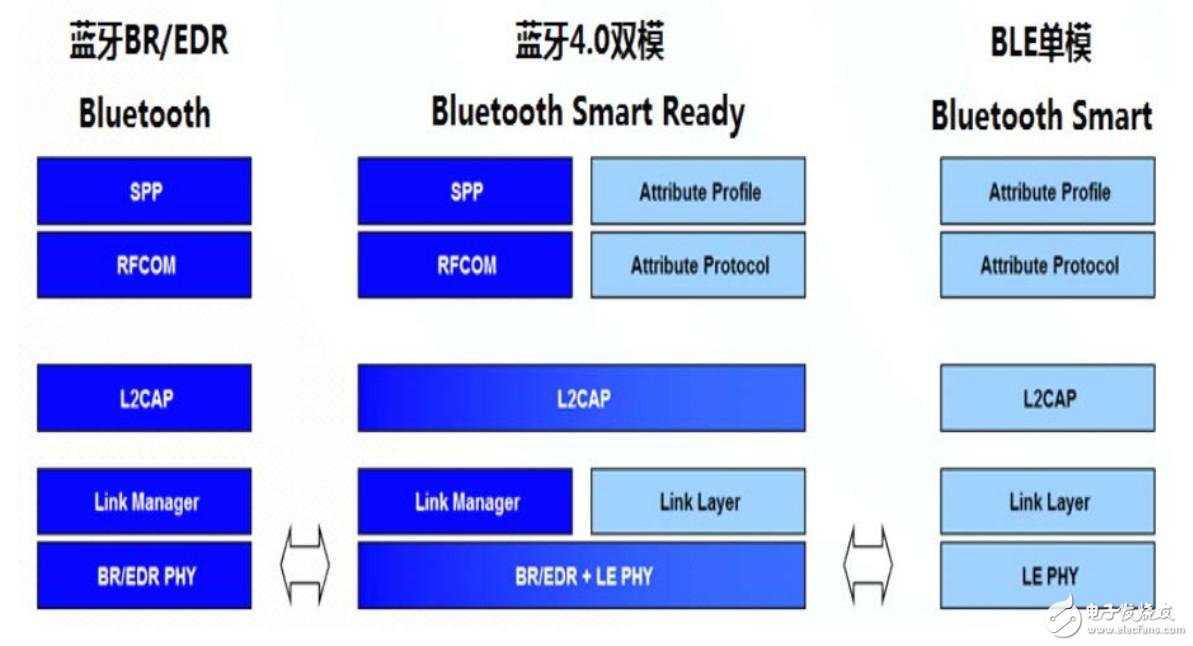Bluetooth Low Energy, referred to as BLE. Bluetooth low energy wireless technology uses many intelligent means to minimize power consumption.
The Bluetooth low energy architecture consists of two chips: a single-mode chip and a dual-mode chip. The Bluetooth single-mode device is a new chip in the Bluetooth specification that only supports Bluetooth low energy technology - part of a technology optimized for ULP operation. The Bluetooth single-mode chip can communicate with other single-mode chips and dual-mode chips. The latter needs to use the Bluetooth low energy technology part of its architecture to send and receive data. Dual-mode chips can also communicate with standard Bluetooth technology and other dual-mode chips that use traditional Bluetooth architecture.
TI's Bluetooth low energy devices for sensing applications are true SoC solutions. The CC254x SoC Series is a highly flexible, low-cost single-mode Bluetooth low-power solution that combines TI's protocol stack, profile software, and sample applicaTIon. Next, we will combine CC254x to explain the development process of Bluetooth 4.0 from the construction of the environment to the development of the Bluetooth 4.0 protocol stack. This tutorial is divided into six parts. The main points of knowledge are as follows:

The first part of the knowledge points:
![]() The first section of the BLE development environment
The first section of the BLE development environment
![]() The second quarter BLE quick experience
The second quarter BLE quick experience
![]() Section III Creating an IAR Project - Lighting LEDs
Section III Creating an IAR Project - Lighting LEDs
![]() The fourth section controls the LED
The fourth section controls the LED
![]() The fifth section LCD12864 display
The fifth section LCD12864 display
The second part of the knowledge points:
![]() The sixth section of the independent button query method
The sixth section of the independent button query method
![]() Section 7 Interrupt Mode of Independent Buttons
Section 7 Interrupt Mode of Independent Buttons
![]() Section VIII CC254x internal temperature sensor temperature acquisition
Section VIII CC254x internal temperature sensor temperature acquisition
![]() Section IX five-way button
Section IX five-way button
![]() Section 10 Buzzer
Section 10 Buzzer
The third part of the knowledge points:
![]() Section XI Serial Communication
Section XI Serial Communication
![]() Section 12 Flash read and write
Section 12 Flash read and write
![]() Section 13 Introduction to the BLE Protocol Stack
Section 13 Introduction to the BLE Protocol Stack
![]() Section 14 How OSAL Works
Section 14 How OSAL Works
![]() Section 15 BLE Bluetooth 4.0 Protocol Stack Startup Analysis
Section 15 BLE Bluetooth 4.0 Protocol Stack Startup Analysis
The fourth part of the knowledge points:
![]() Section XVI Protocol Stack LED Experiment
Section XVI Protocol Stack LED Experiment
![]() Section 17 Protocol Stack LCD Display
Section 17 Protocol Stack LCD Display
![]() Section 18 Protocol Stack UART Experiment
Section 18 Protocol Stack UART Experiment
![]() Section 19 Protocol Stack Five-way Button
Section 19 Protocol Stack Five-way Button
![]() Section 20 Protocol Stack Flash Data Storage
Section 20 Protocol Stack Flash Data Storage
The fifth part of the knowledge points:
![]() Section 21 DHT11 Temperature and Humidity Sensor
Section 21 DHT11 Temperature and Humidity Sensor
![]() Section 22: Slave Communication of the Bluetooth Protocol Stack
Section 22: Slave Communication of the Bluetooth Protocol Stack
![]() The twenty-third section of the Bluetooth protocol stack master-slave host communication
The twenty-third section of the Bluetooth protocol stack master-slave host communication
![]() Section 24 OAD Air Upgrade
Section 24 OAD Air Upgrade
![]() Section 25 SBL Serial Port Upgrade
Section 25 SBL Serial Port Upgrade
The sixth part of the knowledge points:
![]() Section 26 UBL-USB Upgrade
Section 26 UBL-USB Upgrade
![]() Section 27 MT-iBeacon Base Station Using iPhone Air Upgrade
Section 27 MT-iBeacon Base Station Using iPhone Air Upgrade
![]() Section 28 MT-iBeacon Base Station Implements OAD Air Upgrade on the PC Side
Section 28 MT-iBeacon Base Station Implements OAD Air Upgrade on the PC Side
![]() Section 29 MT-iBeacon Base Station About the Use of LightBlue Software
Section 29 MT-iBeacon Base Station About the Use of LightBlue Software
![]() Section 30 How to use the pass-through function of MT-USBDongle
Section 30 How to use the pass-through function of MT-USBDongle
For an introduction to TI's CC254x chip, you can click on the link below to view:
Mainstream Bluetooth BLE control chip detailed (1): TI CC2540
BLE is one of the Bluetooth 4.0 specifications, where the master has up to seven peripherals, low power, low latency, and low throughput.
Six device states
Standby: The device does not transmit and send data, and is not connected to any device.
Broadcast status (Advertiser): Periodic broadcast status
Scanner: Actively looking for devices that are being broadcast
Initiator: Initiator initiates a connection to the scanning device.
Master: Connect to other devices as a master device.
Slave: Connect as a slave to another device.
Five working states
Standby, advertising, Scanning, Initiating, Connected
Four device types
Cnetral host (often as a client): such as mobile phones, PCs
Peripheral slave (often as a Service): such as a heart rate monitor, blood glucose meter
Observer observer:
Broadcast broadcaster:
Connection process:
Peripheral turns on the broadcast --> Central scan slave broadcast --> Peripheral receives the central scan request, Peripheral sends the scan response data to Central --> Central initiates the connection to Peripheral --> start communication.
compatibility

Network Cabinet series including all types metal network cabient which are widely use for residential or commerical use.
Network Cabinet
Network Cabinet,Metal Network Cabinet,Office Network Cabinet,Telephone Junction Cabine
Foshan Dinghan Electrical Technology Co., Ltd , https://www.dinghanelectrical.com